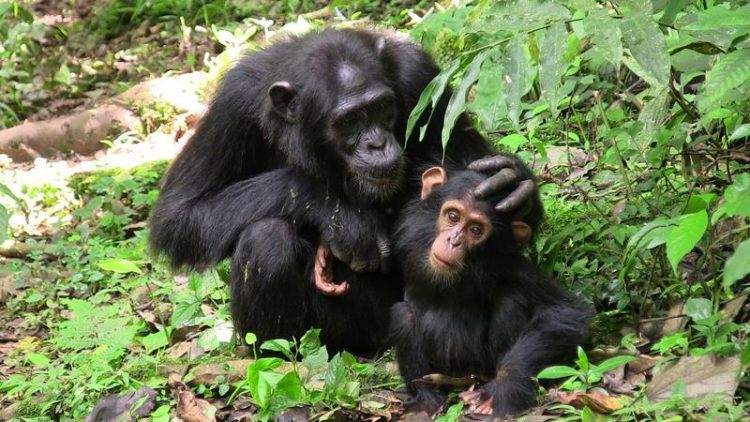Great apes communicate cooperatively

Mother chimp with her infant. Chimpanzees engage in more time-consuming communicative negotiations. Marlen Fröhlich
Human communication is one of the most sophisticated signalling systems, being highly cooperative and including fast interactions.
The first step into this collective endeavour can already be observed in early infancy, well before the use of first words, when children start to engage in turn-taking interactional practices embodying gestures to communicate with other individuals. One of the predominant theories of language evolution thus suggested that the first fundamental steps towards human communication were gestures alone.
The research team of Marlen Fröhlich and Simone Pika of the Humboldt Research Group at the Max Planck Institute for Ornithology together with colleagues from the Max Planck Institute for Evolutionary Anthropology in Leipzig, the Ludwig- Maximilians-University in Munich and the Kyoto University in Japan, conducted the first systematic comparison of communicative interactions in mother-infant dyads of two different bonobo and two different chimpanzee communities in their natural environments.
The bonobos were studied over the duration of two years in the Salonga National Park and Luo Scientific Reserve in the Democratic Rebublic of Congo. The chimpanzees were observed in the Taï National Park, Côte D’Ivoire, and Kibale National Park in Uganda.
The results showed that communicative exchanges in both species resemble cooperative turn-taking sequences in human conversation. However, bonobos and chimpanzees differ in their communication styles. “For bonobos, gaze plays a more important role and they seem to anticipate signals before they have been fully articulated” says Marlen Froehlich, first author of the study.
In contrast, chimpanzees engage in more time-consuming communicative negotiations and use clearly recognizable units such as signal, pause and response. Bonobos may therefore represent the most representative model for understanding the prerequisites of human communication.
“Communicative interactions of great apes thus show the hallmarks of human social action during conversation and suggest that cooperative communication arose as a way of coordinating collaborative activities more efficiently,” says Simone Pika, head of the study.
http://orn.iwww.mpg.de/3702117/news_publication_10530112?c=2168
Media Contact
All latest news from the category: Life Sciences and Chemistry
Articles and reports from the Life Sciences and chemistry area deal with applied and basic research into modern biology, chemistry and human medicine.
Valuable information can be found on a range of life sciences fields including bacteriology, biochemistry, bionics, bioinformatics, biophysics, biotechnology, genetics, geobotany, human biology, marine biology, microbiology, molecular biology, cellular biology, zoology, bioinorganic chemistry, microchemistry and environmental chemistry.
Newest articles

Sea slugs inspire highly stretchable biomedical sensor
USC Viterbi School of Engineering researcher Hangbo Zhao presents findings on highly stretchable and customizable microneedles for application in fields including neuroscience, tissue engineering, and wearable bioelectronics. The revolution in…

Twisting and binding matter waves with photons in a cavity
Precisely measuring the energy states of individual atoms has been a historical challenge for physicists due to atomic recoil. When an atom interacts with a photon, the atom “recoils” in…

Nanotubes, nanoparticles, and antibodies detect tiny amounts of fentanyl
New sensor is six orders of magnitude more sensitive than the next best thing. A research team at Pitt led by Alexander Star, a chemistry professor in the Kenneth P. Dietrich…





















